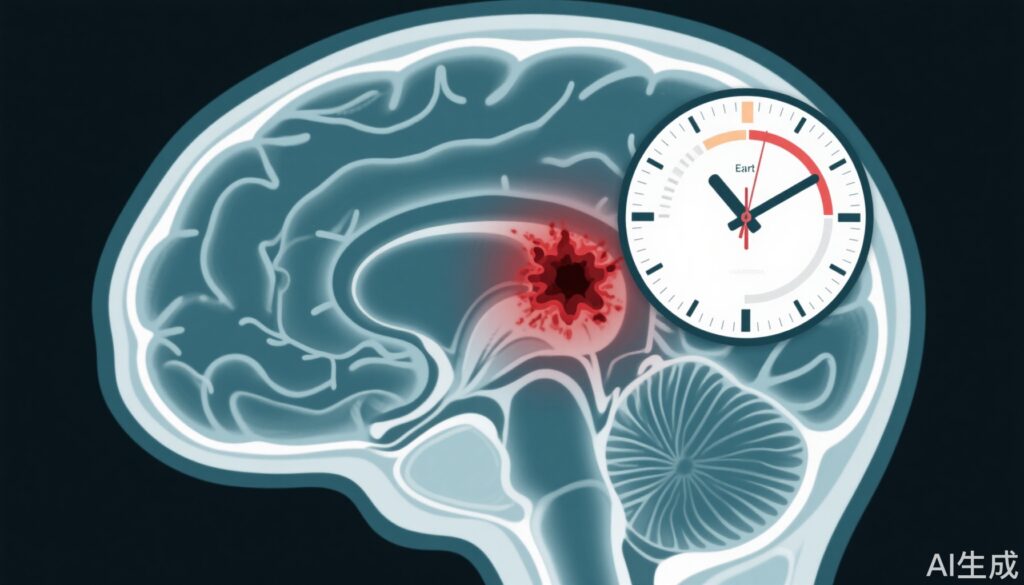Highlight
– Early initiation of intensive blood pressure (BP) lowering within 3 hours of acute intracerebral haemorrhage onset significantly improves functional recovery.
– Intensive BP lowering reduces neurological deterioration, mortality, and serious adverse events compared to guideline-recommended treatment.
– No significant effect of intensive BP lowering on haematoma growth was observed, though benefits on clinical outcomes were notable.
– The benefits of intensive BP lowering diminish as time elapses beyond 3 hours from symptom onset, underscoring the importance of rapid intervention.
Study Background and Disease Burden
Acute intracerebral haemorrhage (ICH) constitutes approximately 10-15% of all strokes worldwide and is associated with high mortality and morbidity. Elevated blood pressure is common in ICH and is hypothesized to contribute to haematoma expansion and worse outcomes. However, the optimal blood pressure management strategy, particularly the intensity and timing of BP lowering, remains controversial. Previous studies have yielded inconsistent results regarding whether intensive BP reduction improves functional outcomes or limits haematoma growth. This pooled analysis of four INTERACT trials aims to clarify the efficacy and safety of early intensive BP lowering, with a focus on the timing of treatment initiation relative to symptom onset, addressing a critical unmet clinical need in optimizing acute ICH management.
Study Design
This investigation combined individual patient data from four randomized controlled trials: INTERACT1 (n=404), INTERACT2 (n=2829), INTERACT3 (n=7036), and INTERACT4 (n=1043).
– INTERACT1–3 enrolled adults presenting within 6 hours of ICH symptom onset with systolic BP >150 mm Hg.
– INTERACT4 enrolled patients with suspected acute stroke causing motor deficit and elevated systolic BP (≥150 mm Hg) within 2 hours of symptom onset; 1029 of these had confirmed haemorrhagic stroke.
Participants were randomized to intensive BP lowering (target systolic BP <140 mm Hg within 1 hour) or to guideline-recommended BP lowering (target <180 mm Hg within 1 hour) using locally available antihypertensive medications. The primary endpoint was functional recovery, assessed by the modified Rankin scale (mRS) score distribution at follow-up. A CT substudy in a subset examined changes in haematoma volume (relative increase ≥33% and absolute increase ≥6 mL) from baseline to 24 hours.
Multivariable logistic regression models adjusted for trial and baseline haematoma volume were employed. The analysis also explored effect modification by time from symptom onset to randomization (continuous variable) and baseline ICH severity using interaction terms.
Key Findings
Among 11,312 patients (mean age 63 years, 35.9% female), the median time from symptom onset to randomization was 2.9 hours. Mean systolic BP at 1 hour was significantly lower in the intensive treatment group (149.6 mm Hg) compared to the guideline group (158.8 mm Hg), with a mean difference of 9.13 mm Hg (p<0.0001).
Intensive BP lowering:
– Reduced the odds of poor functional outcome (mRS scores 3–6) with OR 0.85 (95% CI 0.78–0.91).
– Significantly decreased neurological deterioration within 7 days (OR 0.76, 95% CI 0.66–0.88).
– Decreased mortality risk (OR 0.83, 95% CI 0.75–0.94).
– Lowered risk of any serious adverse event (OR 0.84, 95% CI 0.76–0.92).
In the CT substudy of 2921 patients, intensive treatment showed no statistically significant effect on relative or absolute haematoma growth compared to guideline treatment (p=0.09 and p=0.12, respectively).
Crucially, the benefit of intensive BP lowering on functional recovery and reduction in haematoma growth waned with increasing delay from symptom onset to treatment. A critical cutoff was identified around 3 hours, after which the effect size crossed unity, indicating diminished efficacy.
Expert Commentary
The results provide robust evidence supporting early intensive blood pressure lowering in acute ICH to improve clinical outcomes without increasing harms, despite a lack of clear effect on haematoma expansion. This suggests that mechanisms beyond haematoma growth, such as improved cerebral perfusion or reduced perihaematomal edema, may contribute to the functional benefits.
Leading experts emphasize the critical importance of rapid diagnosis and treatment initiation within the narrow therapeutic window of 3 hours post-onset. The pooled data affirm the need for streamlined prehospital and hospital protocols to achieve early BP control. While the findings are compelling, some limitations include heterogeneity in antihypertensive agents and study settings and the absence of detailed mechanistic imaging data to clarify pathophysiological effects.
Current guidelines increasingly advocate for early intensive BP reduction, and this comprehensive analysis reinforces that stance while highlighting the time-sensitive nature of benefits.
Conclusion
This pooled analysis of the INTERACT trials confirms that intensive blood pressure lowering initiated within hours of symptom onset in acute intracerebral haemorrhage is safe and improves functional outcomes and survival. The maximal benefits are observed when treatment begins within 3 hours, underscoring the urgency of early intervention in ICH management. Although there was no definitive impact on haematoma growth, the improved clinical endpoints emphasize the complexity of acute ICH pathophysiology. These findings inform clinical practice by supporting early intensive BP control and guide future research to optimize therapeutic windows and patient selection to mitigate haematoma expansion risks.
References
1. Wang X, Ren X, Li Q, et al; INTERACT Investigators. Effects of blood pressure lowering in relation to time in acute intracerebral haemorrhage: a pooled analysis of the four INTERACT trials. Lancet Neurol. 2025;24(7):571-579. doi:10.1016/S1474-4422(25)00160-7 IF: 45.5 Q1
2. Hemphill JC 3rd, Greenberg SM, Anderson CS, et al. Guidelines for the Management of Spontaneous Intracerebral Hemorrhage: A Guideline from the American Heart Association/American Stroke Association. Stroke. 2015;46(7):2032-2060.
3. Qureshi AI, Palesch YY, Barsan WG, et al. Intensive blood-pressure lowering in patients with acute cerebral hemorrhage. N Engl J Med. 2016;375(11):1033-1043.



